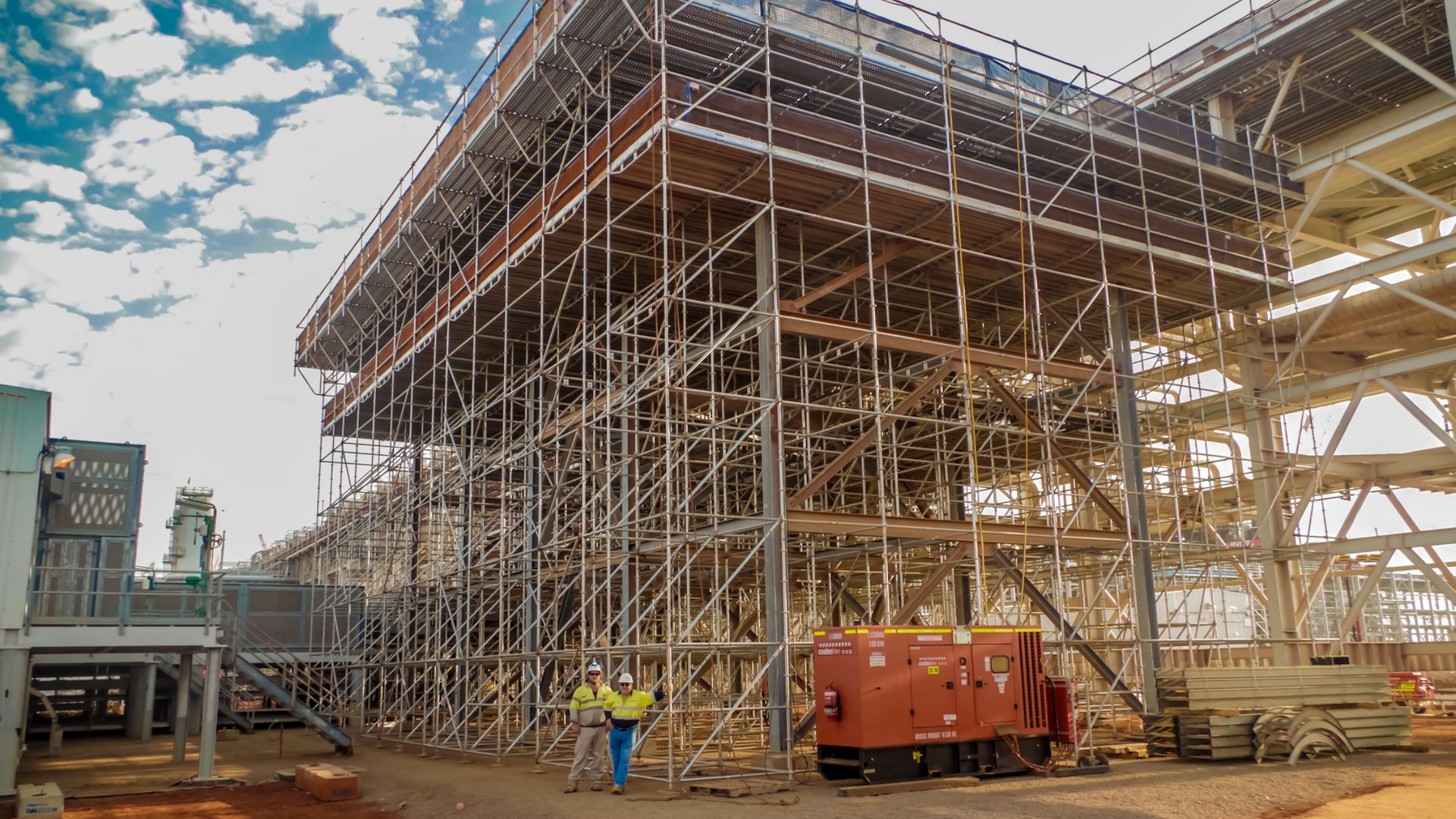SCAFFOLDING SAFETY: 5 STEPS TO TAKE BEFORE ERECTING SCAFFOLDING
July 1, 2019

Everyday, dozens or even hundreds of people – friends and coworkers, beloved sons, daughters, fathers, and mothers – trust their lives and their livelihoods to safe and effective scaffolding solutions.
Scaffolding safety is of prime importance. By definition, these movable, adjustable, customizable construction tools can either prevent or cause dangerous conditions at the job site, depending on how well they function, and how they are used.
On-the-job hazards, close calls, or faulty equipment can have a dramatic impact on productivity and profit. Unsafe conditions not only reduce the enthusiasm of workers on the job site, but can also cause an accident to evolve into a costly lawsuit or workers’ compensation claim.
A holistic approach to scaffolding safety on the job site must take into account external threats, visitors, and the surrounding environment. Here are five steps to proactively create a safe job site before erecting scaffolding.
1. Get the Proper Equipment
Proper equipment is essential to set your job site up for success. Make sure to invest in high-quality Personal Protective Equipment (PPE), including:
- Hardhats with straps to prevent losing the hardhat while elevated.
- Gloves that allow dexterity while not sacrificing protection.
- High Vis apparel rather than vests that may get snagged on equipment during erecting and dismantling (E&D).
- Fall Protection such as retractable lifelines with steel cable vs synthetic lanyards as they are less prone to abrasion and possible fraying.
In addition, plan to take an extra step and provide a few extras to enhance safety, such as supplying:
- Lanyards for wrenches and hammers to prevent overhead tool loss and ‘Struck by’ incidents.
- Torque Wrenches vs. Standard Ratchets to prevent overstressing the equipment and thus reduce damage to structure components.
2. Evaluate Site Conditions
Ground conditions must be evaluated to ensure an adequate E&D process can proceed. However, geotechnical concerns like erosion potential or a high water table are not seen by the naked eye.
In addition, if you are working on industrial or multi-craft sites, coordinate with nearby trades before erection begins to ensure:
- No overhead work is being performed (e.g. cranes, manlifts, overhead structures or mezzanines, etc.). If so, guard against struck by hazards.
- No blasting is planned that may compromise E&D or structure post erection.
- No nearby excavations are happening, which could compromise soil or base
3. Create a Field Level Risk Assessment (FLRA)
A field level risk assessment (FLRA) is used to examine operational and procedural systems on a daily basis to identify hazards that may be necessary to protect workers at a site. By completing a FLRA prior to any work being done on site, possible risks and hazards are identified early and procedures can be put in place to suggest ways for controlling risks and keeping the site safe. It may include the use of some forms or checklists such as:
- Process of erection, which can minimize the hazards associated with the overall process
- Bracing plan
- Material Handling procedures
- Power lines
- Inclement weather
- Loading Capacity for occupants throughout E&D as well as use. For example, will the structure be sufficient for the intended purpose? Does the structure meet criteria where it would need to be ‘engineered’ vs erected by a competent person?
- Establish ‘Pass Line’ and methods of communication for materials to be hoisted and lowered
4. Create a Rescue Plan
A rescue plan should be mapped out for workers to refer to throughout the E&D process. Creating this before erecting scaffolding gives you time to add the proper materials to your inventory to have them on hand in the case of an emergency.
5. TRAIN, TRAIN, TRAIN your staff
When OSHA revised scaffolding safety standards in 1996, studies by the Bureau of Labor Statistics found that 25% of workers involved in scaffolding accidents
had not received safety training. As a manager, you can reduce the risk for your crew by conducting proper OSHA and equipment-specific safety training. OSHA training is designed to protect employees from common hazards such as falls, falling objects, structural instability, and overloading.
Beyond OSHA requirements, make sure to document all of the steps above and share it with your crew before erection begins. Once the job is underway, make sure to reevaluate these safety measures and continue to customize and adapt based on site needs.
Read this article
for additional scaffolding safety tips once your job site is active and underway.
You might also like
AT-PAC Blog

For nearly a decade, AT-PAC's Baton Rouge branch has been a cornerstone of our southern U.S. operations, proudly supporting projects across Louisiana, Missouri, Arkansas and Mississippi. Known for their dependable service and deep industry knowledge, the Baton Rouge team continues to strengthen AT-PAC's presence in the region - helping customers keep projects on track and on time. Under the leadership of Branch Manager Jeremy Smith, this experienced team has built lasting relationships through reliability, responsiveness, and a hands-on approach. Their recent move to a larger, upgraded facility marks an exciting new chapter - expanding their capacity to serve more customers, more quickly than ever before. Hear from Jeremy below about the team's new space, their commitment to customers, and how Baton Rouge continues to raise the standard across the South. Ready to reach out to the team? Contact them here .

AT-PAC established its presence in Australia with one clear mission: to deliver world-class scaffolding solutions built on innovation, safety, and reliability. This month, we are proud to celebrate this milestone alongside the customers, partners, and employees who have made the journey possible. A Journey of Growth and Innovation From our very first projects to supporting some of Australia’s most iconic and complex industrial facilities, AT-PAC Australia has continuously evolved to meet the needs of our customers. Over the past decade and a half, we have grown from a local provider into a trusted partner, recognized for delivering integrated scaffold solutions across multiple sectors, and 5 branch locations. Key Milestones Over 15 Years 2010 – AT-PAC launches in Australia, introducing the globally trusted Ringlock System to the local market. 2013 – Established Global Site Solutions and Hi-Vis® Scaffold Management Software and deployed to Wheatstone LNG. 2015 – Establishment of our dedicated Australian based Design & Engineering team, enabling tailored solutions for high-risk and large-scale access needs. 2020 – Significant role in supporting LNG and energy sector projects, delivering some of the country’s most challenging scaffold builds. 2023 – Integration into the Umdasch Group (Doka), strengthening our global reach and resources while reinforcing our local focus on Scaffolding. 2024 – Major partnerships secured in infrastructure and industrial sectors, with enhanced scaffold management technology (Hi-Vis®) rolled out to support customers. 2025 - AT-PAC becomes part of the umdasch Industrial Solutions, a division of the Umdasch Group. Looking Ahead While 15 years is a proud achievement, we view it as just the beginning. Our commitment remains to provide safe, efficient, and innovative solutions that help our customers succeed. The future will see AT-PAC Australia continue to expand our service offerings, strengthen local partnerships, and invest in digital and engineering innovation and open new branch locations. A Thank You to Our Partners This milestone belongs not just to AT-PAC Australia, but to the customers and partners who have trusted us along the way. Your challenges have shaped our solutions, and your projects have inspired us to continuously raise the Ledger. Here’s to the next 15 years of innovation, collaboration, and building safer industry together. AT-PAC is celebrating 30 years of business, read more here .

